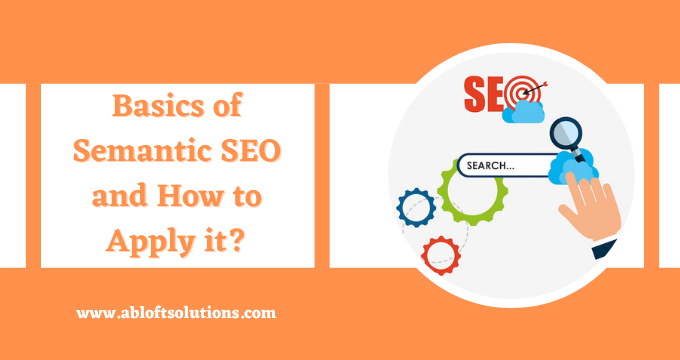Basics of Semantic SEO: Semantic SEO is all about adding more meaning and depth to web content. With the help of Semantic SEO, Google crawlers understand web content in a specified way. Furthermore, crawlers treat the content as authoritative, and user search is intent based, and hence, pushes it higher in the rankings.

This blog will focus on the basics, benefits and strategies that can be adopted for Semantic SEO. This reading will turn into a specific guide on how to implement Semantic SEO and how a business or individual can incorporate Semantic SEO into their Internet Marketing or Search Engine Optimization strategy.
Table of Contents
What is Basics of Semantic SEO?
Semantic SEO is about adding more meaning and depth to the content. In short, content that is more laser focused on user search intent is more likely to rank with Semantic Search especially now. Semantic search is a data search technique that focuses on understanding the meaning of the search rather than the keywords.
As search engines become increasingly advanced, they rely on semantic search. Therefore, Semantic SEO focuses on content that has more depth and is of higher quality, and can rank on Semantic Search.
With advances in Google’s algorithm, content can no longer be filled with keywords. A search result will not show such results and these are old digital marketing practices.

To better understand and improve the quality of content, Google has taken a meaningful and humane approach to ranking, analyzing and displaying content on search results.
With various updates over time, Google’s algorithm became smarter and more sophisticated in ranking based on its ability to understand content and resolve user search intent.
Therefore, the ranking criteria changed and the definition of quality content changed as they became more about semantic analysis, focusing on deriving meaning from the text. With this requirement, Semantic SEO should always be a part of SEO strategy.
Searchers now rely on search engines to get an in-depth explanation of any topic. People, most of the time, don’t look for short answers on search engines. They expect Google to provide accurate and thorough search results.
Therefore, Semantic SEO is all about writing intensive content that improves the user search experience. Pages that answer multiple questions can allow users to find answers on a single page, which is convenient for the user and also for the search engines themselves.
What are the benefits of Semantic SEO?
Semantic SEO has a lot of benefits, even though it can take time. However, the benefits are worth the time spent and there are some benefits:
- Content can be ranked in the ‘People All Ask’ section of Google.
- Google crawlers see the content as high quality.
- Better opportunities for internal linking.
- Google begins to see a business as an authority in its niche.
- Rank higher on affiliate keywords.
- Semantic SEO can reduce the bounce rate of a page.
Meaningful SEO Strategies That Ensure High Rankings
SEO strategies with Semantic SEO revolve around improving the interpretation of the topic and the meaning of the web content. The strategies created are as follows:
1. Build and optimize for keywords and topic groups
Nowadays, it is better to create web pages that are optimized for multiple keywords rather than a single keyword. A keyword cluster is a group of similar keywords within the same semantic cluster.
By adding more keywords, a business can easily rank for a group of keywords containing a single page. It simply provides more opportunities for clicks and lead generation.
Get Best Digital Marketing Services with one of the Digital Marketing Company in India. By Abloftsolutions.com.
On the other hand, a topic group is a group of pieces of content that revolve around a central theme. Typically, several similar topics connect to a larger topic. Subject groups depend largely on the products or services of a business. Finally, these topic and keyword clusters provide a website with internal link or link building opportunities.
2. Improve the content grammatically and in depth
With clarification and depth in the content, the length of the content increases. Even though content length is not a ranking factor, however, it exhibits strong semantic signals. Also, length should be increased with quality content and not with keyword stuffing or repetition.
Keep in mind that Google is smart enough to understand synonyms and, therefore, content should not be filled with keywords only.
Increasing the depth and readability of content can benefit the user as well as the search engine in presenting real results to the user as it uses semantic search to display relevant results. Relevant content is what is promoted on searches.
3. Write content that addresses the user’s query
Answering user questions for users is an easy way for a business to establish rights in its location. Also, Google has always been a platform to answer user questions.
So, naturally, it will promote content that answers user queries. All Google searches are for one question, more or less. A search query is performed to look for relevant results or answers and people rely on the search engine with the most accurate results.
Google’s ‘People Ask Questions’ section appears for about half the searches and is often in the first place. Therefore, answering user queries can help content rank at the top of semantic searches and is an important part of overall SEO services.
4. Include Structured Data
Structured data content is meant to be delivered directly to search crawlers. Therefore, structured data brings clarification regarding the content to Google crawlers. An example might be of using the product schema on the product page.
It informs Google about information like types, sizes of products etc. With the right external linking, images, references, etc., the search engine is clear about the content of the page. With a clear definition, content can be easily ranked on Semantic Search or Google Search.
5. Use Content Optimization Tools
Content optimization tools help an internet marketing team optimize their content as well as research niche-related topics. An SEO content writer, in particular, can easily identify words based on rankings.
With key themes chosen, it is convenient for businesses to demonstrate authority and even create content. Certain content optimization tools can help a writer from start to finish.
However, some tools provide support for writing in a specific area. Lastly, content optimization tools make it convenient for writers to optimize content at every step and easily integrate semantic SEO into content marketing and SEO. With such accuracy, any business can rank on a semantic search.
Conclusion
In short, Semantic SEO benefits a company in invaluable ways. It is a modern, powerful SEO strategy that can help businesses rank on Semantic Search.
With the mentioned benefits and strategies, a business can easily dominate Semantic Search on Semantic Web. Therefore, advanced SEO services should include Semantic SEO and hence, every business should move towards it and implement Semantic SEO strategy.
Post Tag: Basics of Semantic SEO, Basics of Semantic SEO in English, Basics of Semantic SEO, Semantic SEO



